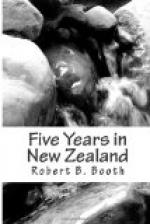At this time a complete muster is made; all hands turn out on the hills, and every sheep is brought in that can be found. Not infrequently in the hilly country an exciting chase is had after a wild mob that have defied the exertions of the shepherds and their dogs for a considerable time. These animals will run up the most inaccessible places, skirt the edges of precipices at a height at which they can be discovered only by the aid of a telescope, and have been known to maintain their freedom in spite of man or dog for years. When at length caught they present a ludicrous appearance; their fleeces have become tangled and matted, hanging to the ground in ragged tails, and can with difficulty be removed, their feet have grown crooked and deformed, and they rarely again become domesticated with the flock.
The shearing is carried on in a large shed, divided into pens or small compartments, each connected separately with the attached yards. It is usually done by contract, the price being L1 to L1 5s. per hundred sheep. Each man has his pen, which is cleared out and refilled as often as necessary, and at each clearance the number therein are counted to his name. The shorn sheep are passed direct to the branding yard, and from thence to a common yard, from which all are counted out at nightfall for return to the run.
A good shearer will clip one hundred sheep in a day, the average for a gang of men being 75.
Upon the fleece being removed it is gathered up by an attendant placed for the purpose, and handed over to the sorter, who spreads it upon a table and removes dirty and jagged parts, and sometimes it is classed. It is then rolled up and thrown into the wool press to be packed for export.
The wool bales so pressed measure 9 ft. by 4 ft. by 4 ft., and contain on an average one hundred fleeces, and each fleece runs from three to four pounds in weight. The lambs’ wool is pressed separately, and commands a higher price than that of the adult sheep.
The hand press is a wooden box, made the size of the canvas bale, which is suspended therein by hooks from the open top; the box has a movable side, which is loosened out to give exit to the bale when pressed. The pressing is done by the feet, assisted by a blunt spade, and the bales are generally very creditably turned out, the sheep-farmer priding himself on a neatly pressed bale. When pressed the end is sewn up and the bale rolled over to a convenient place for branding, when it is ready for loading on the dray.
Previous to shearing, the sheep are sometimes driven through a deep running stream and roughly washed, to remove sand and grease. Wool certified to have been so cleaned will command a higher price than unwashed wool.
At the time to which I refer, most of the runs in Nelson Province were “unclean”—that is, infected with scab; and it became so general that it was considered almost impossible to eradicate. The disease was most infectious. A mob of clean, healthy sheep merely driven over a run upon which infected sheep had recently fed would almost surely catch the disease.




